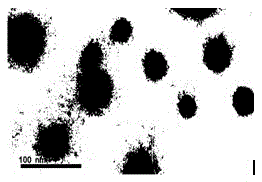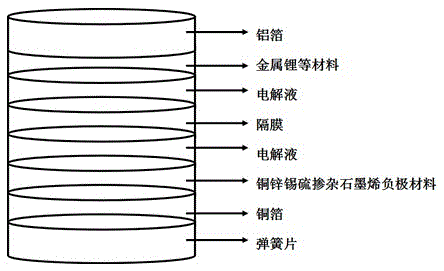Preparation method of graphene lithium ion battery anode material doped with copper zinc tin sulfide
A lithium-ion battery, copper-zinc-tin-sulfur technology, applied in the direction of battery electrodes, negative electrodes, secondary batteries, etc., can solve the problem of difficulty in ensuring electrical conductivity, capacity and service life performance, degradation of lithium-ion battery cycle performance, and loss of electrochemical activity and other problems, to achieve the effect of easy availability of equipment and raw materials, environmental protection and pollution-free reaction process, and improvement of electrochemical activity
- Summary
- Abstract
- Description
- Claims
- Application Information
AI Technical Summary
Problems solved by technology
Method used
Image
Examples
Embodiment Construction
[0020] The present invention firstly prepares copper-zinc-tin-sulfur solution with hydrated copper acetate, zinc acetate, dihydrate stannous chloride, and sodium sulfide, and dopes the graphene solution purchased on the market in the copper-zinc-tin-sulfur solution, and then passes through a A series of preparation procedures to prepare copper-zinc-tin-sulfur-doped graphene sol, and then obtain copper-zinc-tin-sulfur-doped graphene nanoparticle materials, and finally grind and mix polyvinylidene fluoride, and use 1-methyl-2 - The pyrrolidone solvent is mixed until a certain viscosity is evenly brushed on the copper foil to prepare the negative electrode material of the lithium ion battery.
[0021] Specifically, the preparation method of copper-zinc-tin-sulfur-doped graphene lithium-ion battery negative electrode material of the present invention comprises the following steps:
[0022] Step 1: copper acetate hydrate, zinc acetate, stannous chloride dihydrate are added respecti...
PUM
 Login to View More
Login to View More Abstract
Description
Claims
Application Information
 Login to View More
Login to View More - R&D
- Intellectual Property
- Life Sciences
- Materials
- Tech Scout
- Unparalleled Data Quality
- Higher Quality Content
- 60% Fewer Hallucinations
Browse by: Latest US Patents, China's latest patents, Technical Efficacy Thesaurus, Application Domain, Technology Topic, Popular Technical Reports.
© 2025 PatSnap. All rights reserved.Legal|Privacy policy|Modern Slavery Act Transparency Statement|Sitemap|About US| Contact US: help@patsnap.com



